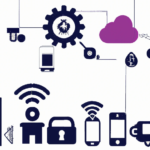The term “Internet of Things” (IoT) describes the interconnection of gadgets, such as automobiles, household appliances, and other objects, which are outfitted with sensors and software to enable data collection and exchange over the internet.
IoT devices can be used for a number of purposes, such as:
Smart homes: remote or automated control of lighting, temperature, and other home features
Monitoring traffic, air quality, and other public services in smart cities will increase productivity and quality of life.
Industrial internet: observing and managing production processes and machinery to increase productivity and decrease downtime
Healthcare: remote vital sign monitoring and data gathering to enhance medical research and treatment
Agriculture: tracking crop development and soil moisture to improve irrigation and farming methods.
These are only a few applications of IoT; it can be utilised in numerous other fields and sectors.
IoT applications in several industries:
Retail: By offering individualised offers and recommendations, IoT devices like beacons and RFID tags may be utilised to track inventory and enhance customer experiences.
Energy: IoT devices can be used to monitor and regulate energy usage, which can save costs and increase efficiency. Examples include smart metres and residential energy management systems.
Transportation: The performance of cars can be tracked, monitored, and optimised using IoT devices like GPS trackers and telematics systems.
Environmental monitoring: By keeping an eye on air quality, water levels, and other environmental variables, IoT devices like sensors and drones can help mitigate the effects of natural disasters and increase sustainability in general.
Building management: By controlling temperature, lighting, and security with IoT-enabled devices, buildings may operate more efficiently.
IoT offers limitless potential applications across all sectors where data collecting and automation can boost productivity, cut costs, and improve customer experience. The volume of data created by the growing IoT device population can aid in decision-making and the development of new business models.
Disadvantages:
Although the Internet of Things (IoT) has many advantages, there are also some possible drawbacks to take into account:
Security: IoT devices are a target for hackers and cybercriminals because they frequently collect and communicate sensitive financial and personal data. Identity theft and data breaches may result from this.
Privacy: Without the user’s awareness or agreement, IoT devices may gather a lot of personal information that may be used for targeted advertising and other purposes.
Dependency: As more and more technologies are made available online, individuals may begin to depend on them in order to live their lives. Failure of the devices may result in inconvenience or, in certain situations, harm.
Complexity: Managing and keeping up with an increasing number of linked devices can be challenging. Compatibility problems and other concerns may result from this.
Interference: As IoT devices are used more frequently, there may be more radio frequency interference, which could affect wireless networks and other electrical devices.
Cost: IoT devices can be pricey and may need to be maintained, upgraded, or replaced on a regular basis.
Limited battery life: Some IoT devices have a battery life that is limited, which can be a concern if the battery needs to be replaced or charged frequently.
Limited processing power: The performance and usefulness of some IoT devices may be impacted by their limited computing power.
Overall, even though IoT provides numerous advantages, it is crucial to be aware of any potential drawbacks and take precautions against them.
Discover more from TechResider Submit AI Tool
Subscribe to get the latest posts sent to your email.



